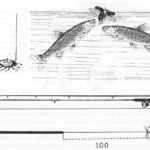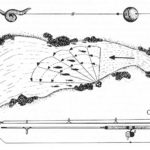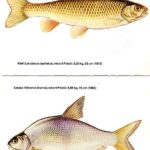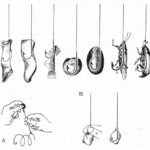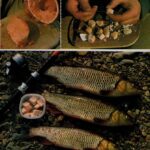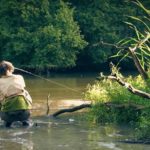Zasady zimowego połowu kleni
Zimowy połów kleni zasługuje na specjalną uwagę już choćby dlatego, że innych ryb w tym czasie łowić się nie da. Ma też, oczywiście, swoją specyfikę. Za najskuteczniejsze zimowe przynęty trzeba uważać jelita drobiu, oczywiście z zawartością, i równie „aromatyczne” wnętrzności zwierzęce – wątrobę, śledzionę, nerki. Sprawdzają się zimą także liczne przynęty uniwersalne, uważamy je jednak za awaryjne.
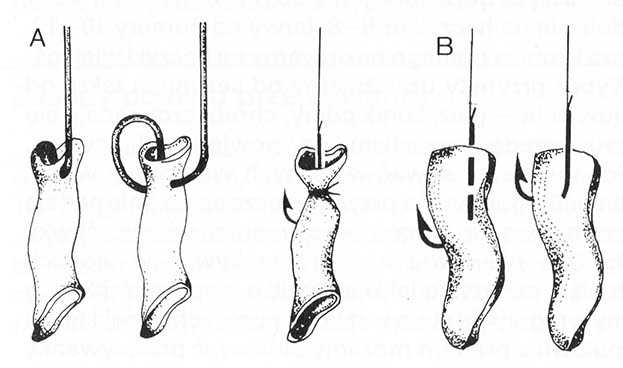 Typowe przynęty do zimowych połowów klenia: A -jelita drobiu (najlepiej nawet z zawartością), B — cienkie płaty wątroby zwierząt domowych (jak również słonina).
Typowe przynęty do zimowych połowów klenia: A -jelita drobiu (najlepiej nawet z zawartością), B — cienkie płaty wątroby zwierząt domowych (jak również słonina).
Zimą trzeba brać poprawkę na częściowo ograniczoną aktywność, także żerową, klenia, co skłaniać powinno do wybierania przynęt o bardziej drażniącym działaniu. Takie właśnie własności mają wymienione przynęty. W porównaniu z latem kleń tylko częściowo zmienia żerowiska – nigdy nie przemieszcza się do najgłębszych spokojnych partii, a na głębokościach ponad 2 m na ogół nie zatrzymuje się; także w zimie szukać go trzeba w umiarkowanych prądach, zwłaszcza zaś na pograniczu bystrzyn i odcinków spokojnych – najlepiej na głębokości 1-1,5 m. Jelita dzielimy na porcje o długości 1,5-2 cm – tak, by pozostała w nich zawartość wypływała stopniowo do wody. Dobrze jest przygotować w domu i przewiązać nicią odpowiedni zapas. Inne wnętrzności kroimy na cienkie kawałki o długości 3-4 cm. Wybieramy technikę połowu pozwalającą na dotarcie do kleni przynęty swobodnie unoszonej przez wodę. Wypłukiwany zapach przynęty uprzedzi ryby wcześniej i ich czujność się zwiększy, a więc wkrótce po zarejestrowaniu przez nie przynęty można oczekiwać brania. Nie należy czekać zbyt długo, lepiej spróbować po chwili kawałek niżej. Może nam także pomóc wymienienie wypłukanej przynęty na świeżą, o silniejszym zapachu.Uparte pozostawanie w jednym miejscu z tą samą przynętą – bez względu na to, czy coś złowiliśmy – może doprowadzić do tego, że kleń zacznie nawet w najbardziej apetycznym smakołyku dopatrywać się podstępu i będzie omijać go z daleka.
Pozostałe metody połowu
Większe klenie, jak już wspominaliśmy, są bardziej drapieżne, dlatego typowy połów na żywca może zapewnić nam medalowe zdobycze. Zasady połowu są takie same, jak w wypadku innych drapieżników, tu jednak wystarczy nam delikatniejszy sprzęt, oczywiście bez przyponu stalowego. Łowimy na 3-4 centymetrowe ukleje, różanki itp. Za znakomitą przynętę trzeba uważać 4-5 cm ślizy i kozy, które na klenie działają wręcz prowokująco.
Poszczególnych wariantów klasycznej metody gruntowej nie można uważać za najodpowiedniejsze na klenia. Problem jednak w tym, że kleń w normalnych warunkach nie podejmuje dłuższych wypraw po pożywienie; najchętniej biernie czeka na coś, co pojawi się w jego polu widzenia. O ile dobrze wytypujemy jego żerowisko, weźmie i na przynętę podawaną w ten sposób.
Za interesującą innowację można uważać połów kleni na młode listki wierzby i podobnych zieleniejących wiosną drzew. Skuteczność tych młodziutkich listków da się wyjaśnić i tym, że stosujemy je na początku okresu wegetacyjnego, kiedy odpowiedniejszego pokarmu jest mało i uczucie głodu zmusza klenia do skonsumowania nawet mniej typowych rzeczy. Młode pędy mają, oczywiście, także wartość odżywczą. Przed połowem trzeba jednak klenie zanęcić rzucając na powierzchnię listki. Jeśli okaże się, że ryby je zbierają, w następnej dawce może być ukryty mały haczyk.
